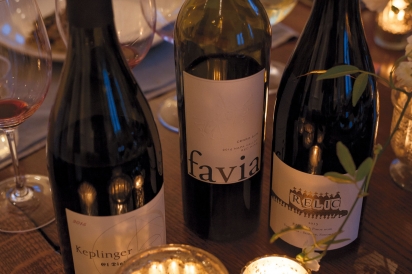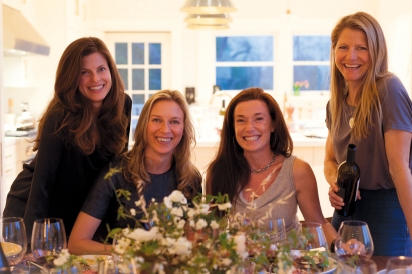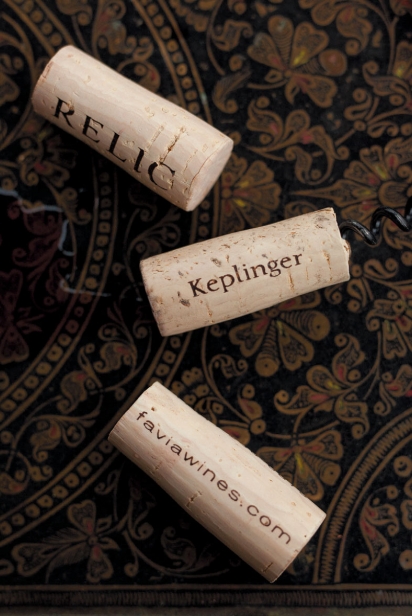A window into three wonderful women of wine
As I have written in my letter from the editor many times over the past nine years, I am grateful every single day for the work of editing and publishing Edible Marin & Wine Country. I am honored and humbled to have this platform from which to tell the tales of the extraordinary good food and drink producers in our area. These folks are my superheroes. Their stories are food for my soul, while the fruits of their labor nourish and delight my physical being.
Along the way, many of them have also become dear friends. For that I am especially grateful. So when I was deciding who would be the perfect writer to tell the stories of these three wonderful women in wine, I selfishly decided to keep this one for myself. I had lots of questions for Annie, Helen and Schatzi that had not come up in our social conversations, so I gathered them together over good food and wine (of course) at Annie’s historic home and winery in Napa’s Coombsville AVA, and fired away.
Having grown up in the South, where distilled spirits were king, my first taste of “wine” was Tickle Pink by Boone’s Farm, purchased by a high school friend with a fake ID. Let’s just say it was not imbibed for its taste… So I was very curious about how these three fellow non-natives to Wine Country had become so deeply connected to the fascinating world of wine.
Helen Keplinger is co-owner of Keplinger Wines and Vermillion Wine with her husband, DJ Warner, and the winemaker for Grace Family Vineyard, Carte Blanche, Kerr Cellars and Waterfall, among others. She says that when she was growing up in Ohio her parents never had water glasses on the dinner table—just wine glasses. Her parents had honeymooned in France, visiting Michelin-starred restaurants and wineries. Her father kept a wine cellar and her mother was an excellent cook, making homemade pastas and fresh-baked baguettes for weeknight dinners. As a kid, Helen collected rocks and wine bottles—an early hint of her truest interests.
Schatzi Throckmorton, business manager of Behrens Family Winery and co-owner with her husband, Michael Hirby, of Relic Wine Cellars, grew up in Iowa. Her parents also drank wine every night. Often Emerald Dry and Hearty Burgundy, but they also had a cellar stocked with special wines, Gaja being the most notable in Schatzi’s memories.
Annie Favia, viticulturalist and co-owner with her husband, Andy Erickson, of Favia Wines and Room wines, grew up at her mother’s hip, helping her tend the extensive vegetable gardens and fruit trees that graced their family property in Connecticut. A classical ballet dancer, Annie later studied French literature and art history in college. While living in France during her junior year, she decided that she wanted to pursue a career in wine. It was either that or teach. She went west for wine.
As luck would have it, one of her sisters-in-law, who was living in New York at the time, was friendly with Chef Charlie Palmer, and it was Chef Palmer who connected Annie to the legendary Su Hua Newton, the first Asian female winemaker in the U.S. Newton offered her an office job at her Newton Vineyards in the Napa Valley, and Annie made her way to California in 1993.
Also at Newton at the time was renowned winemaker John Kongs-gaard. Annie and Kongsgaard connected over their mutual love of classical music, and when she told him she did not think the business side of wine was her thing, he introduced her to Cathy Corison, who quickly became a mentor for Annie. The two worked harvests together in 1996 and 1997, while Cathy was building her winery in St. Helena.
One winter day, Cathy pulled Annie in to help prune the Kronos Vineyard, which surrounds the Corison Winery, and Annie was hooked. It was a beautiful, bluebird winter day in the valley, and in Annie’s mind the contrast between the wide open blue sky, the green mountains, the yellow mustard growing between the vines, and the dark, damp cellar could not have been more stark. The vines were her thing. Soon thereafter, Annie enrolled in the viticulture program at Napa Valley College, where she earned a degree with near-perfect marks.
One day during harvest, famed viticulturist David Abreu arrived on the crush pad, personally delivering grapes to Cathy. Annie was already familiar with David’s work, his Cabernet Franc from the neighboring Madrona Ranch being a wine that particularly spoke to her. David’s precision-driven style of viticulture also resonated with Annie’s “Virgo tendencies,” she says. The two bonded over their mutual affinity for plants and farming, and Annie ended up working as viticulturist at David Abreu Vineyard Management for 12 years.
With Abreu, she went on to help plant and manage some of Napa Valley’s most prestigious properties, including Harlan Estate, Bryant, Colgin, Araujo and Screaming Eagle. For support, she leaned on her female mentors, including Corison, Mary Maher (who now oversees vineyard operations at Harlan Estate) and Ann Kraemer, who went on to start Shake Ridge Vineyards, this time asking for Annie’s input. Annie’s hard work and diligence definitely paved the way and opened doors for many of the young female viticulturists who are in the industry today, and those who will be joining their ranks.
Looking back on her path, Annie notes how critical it was that she stayed curious, following her heart to help her make the right choices at the many forks in her road.
Schatzi says that she learned the appreciation of fine wines from her great-uncle, a surgeon she describes as a Renaissance man who also hybridized daffodils and raced cars. A wine connoisseur, he had persuaded a governor of Iowa to allow him to set up the Iowa Wine Advisory Board, essentially enabling himself and his buddies to import a lot of great wines that might have been prohibited by state alcohol regulations at the time. Back in the day (and still today), Iowa kids could get their drivers’ permits at 14, so sipping a little wine at the same age was a no brainer.
An African history major, she had been accepted into graduate school at Cambridge University to further pursue the subject (clearly she and Annie could have ended up as fellow college professors rather than women of wine) when her great-uncle suggested she spend the gap year between college graduation and matriculating at Cambridge in the California Wine Country. That was 1999, and, needless to say, graduate school enrollment is still being deferred.
Schatzi spent a year working at Folie À Deux Winery before being hired by Behrens & Hitchcock Winery (now Behrens Family Winery). Bob Hitchcock, the business partner at Behrens & Hitchcock, was looking to step back, and it wasn’t long before she was running the business. There were only a handful of female general managers in the wine industry at that point. Lacking role models, the learning curve was steep.
She recalls that almost immediately after she arrived, the winery received a score in the high 90s from wine critic Robert Parker for its 1999 To Kalon Cabernet, and a large part of her days were spent calming angry customers demanding more of the wine than was available. Nice work if you can get it.
18 years later, Schatzi is still the business manager at Behrens Family Winery. She and Michael, who she met while he was an assistant winemaker at Behrens, started their own brand, Relic Wine Cellars, in 2001. Wine lovers first and foremost, Relic began as a passion project and playground for varietals they weren’t able to make at their day jobs; just three barrels of Pinot Noir being their first endeavor. In 2009, the couple purchased property in Napa’s Soda Canyon and began building their own winery and cave. They did this without financial partners, which, I will add, is a rarity these days given the high cost of Wine Country real estate and construction. The construction process, which Schatzi spearheaded, specifically the navigation of permitting requirements at the state and county levels, was grueling, but they persevered, moving their production to the winery in 2015. The winery is now home to their Sonoma Coast Pinot Noirs and Chardonnay, as well as old vine Rhone varietals and Cabernet made with fruit from Napa Valley.
Schatzi and Helen met on a canoe trip with mutual friends including pioneering female winemaker Heidi Barrett and her husband, Bo Barrett. Helen was working for Barrett as the assistant winemaker at Paradigm Winery and Schatzi had been helping Heidi with administrative tasks and even doing some babysitting for the Barrett kids. Hitting it off instantly, the two realized they lived just three houses apart. They’ve been fast friends ever since.
Helen had attended the graduate program in enology at UC Davis with Annie’s husband, Andy Erickson, and can vividly recall the night Andy told her about meeting Annie—a match made in winemaking heaven. It was the night before Annie was moving to Hawaii to work for sommelier Randy Caparosa at Chef Roy Yamaguchi’s Roy’s restaurant. Annie did follow through on her plan to leave Napa Valley, but returned five months later. She and Andy married in 1998 and have two high-school-aged daughters.
Helen had planned on a career in medicine. After graduating from Smith College, she lived in Boston doing medical research at Mass General Hospital, all the while avidly reading about and drinking through the different wine regions of the world. Through this “extracurricular” research, she found that she greatly preferred reading about wine to reading medical journals and, by luck, she says, she found the graduate program in enology at UC Davis. When she broke the news to her parents, her dad replied, “I would be just as proud to see your name in Wine Spectator as any medical journal!” She hung up her lab coat, took time off to travel and then headed west.
After Helen’s first year at UC Davis, she sent internship inquiries to the winemakers she admired most, including Heidi Barrett, then (and now) winemaker at Paradigm Winery. It was Heidi who gave Helen’s resume to Paradigm’s owner Ren Harris, saying, “You have to hire this girl!” Ren did.
After this initial stint in Napa, Helen left to gain experience making wine in other regions, knowing that she would eventually return. In Santa Barbara, she worked with the intelligent and feisty Kathy Joseph before making her way to the Priorat region of Spain. After three years in Spain, Helen returned to Napa to work again with her mentor, Heidi Barrett, this time at Kenzo Estate. It was here that Helen also worked with Kenzo’s viticulturalists David Abreu and Annie Favia—and a wonderful friendship with Annie grew out of that collaboration. Helen left Kenzo after five years to work at Bryant Family Vineyard, while growing her own small brand on the side.
Helen started Keplinger Wines in 2006, making 250 cases of Grenache and Syrah from grapes from a single site high above Knights Valley. She says that she had loved the challenge and reward of farming and making Grenache in Spain, and wanted to focus on single- vineyard Rhone varietals from rocky, steep vineyards reminiscent of those in Priorat. She gradually grew this small label to a boutique-size production of 1,800 cases, gaining recognition for her work and finally landing on the cover of the Wine Spectator in 2014 (her father was thrilled!).
All three ladies give huge thanks to the few but powerful female pioneers of California winemaking including Heidi Barrett, Cathy Corison, Mary Maher, Kathy Joseph and Ann Kraemer. They also note the many “women in wine” groups that exist today, formally and informally supporting each other and encouraging more women to get into the wine business, as well as supporting female-oriented causes beyond the wine industry.
Schatzi and Helen recently worked together to create a wine to be sold to support the documentary film The Uncondemned, about the first international tribunal to prosecute rape as a war crime and act of genocide, fusing not only wine and philanthropy but also Schatzi’s college studies in African history. Helen also collaborated with San Francisco restaurateur Shelley Lindgren to develop a wine to be sold to raise money for La Cocina, the nonprofit culinary business incubator, and works with the group Wine for the World, which promotes female winemakers from up-and-coming wine regions worldwide.
Three of the five employees at Favia Wines are women, including associate winemaker Jessica Tarpy-Shaheen. At Relic, all but one staff member is female. Keplinger Wines has an even mix of women and men. None of this was a pre-determined effort to hire more, or only, women, they say. These were simply the most qualified candidates for the positions when they opened up, and the best fit for each winery’s unique culture.
Three hours later, we had covered an awful lot of ground, not only their respective experiences in the wine industry, including the best places to get a little privacy to use a breast pump while you’re out in the field during harvest, but lots of other important things like tips on how to get your children into your choice of schools, the best tart crust recipe (Helen had made a divine wild mushroom tart to share for dinner, combining recipes from Tartine and Chez Panisse like she blends fine wines), unique sources for tasting room glassware, and the respective virtues of galettes versus pies versus crisps (Schatzi’s apple crisp for the win!).
After savoring delicious tea from Annie’s newly launched herbal tea line, Erda (like I said, she’s a rock star), we cleaned and put away the dishes, reluctant to break the spell of this all-too-rare “girl time.” Driving home, and many times since, I recalled special moments of connection and understanding that we shared, those that only happen among open-hearted, generous and genuinely comfortable in their own skin people—male or female.
ErdaTea.com • FaviaWine.com • KeplingerWines.com • RelicWines.com • RoomWines.com • VermillionWine.com







